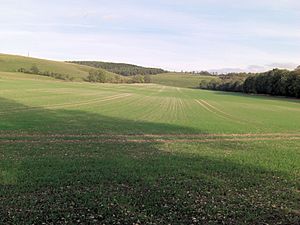Hog's Hole facts for kids
| Site of Special Scientific Interest | |
 |
|
| Area of Search | Berkshire |
|---|---|
| Interest | Biological |
| Area | 23.7 hectares (59 acres) |
| Notification | 1988 |
| Location map | Magic Map |
Hog's Hole is a special natural area located south-west of Newbury in Berkshire, England. It covers about 23.7-hectare (59-acre), which is roughly the size of 58 football fields! This site is officially known as a Site of Special Scientific Interest (SSSI). This means it's a protected place because it has very important plants and animals that need to be looked after.
Contents
Exploring Hog's Hole: Geography
Hog's Hole is one of three really important chalk grassland areas in the North Wessex Downs. The other two are Rushmore and Conholt Downs, and part of Inkpen and Walbury Hills.
This area features a "dry valley," also called a combe. This valley was carved out of Middle and Upper Chalk rock. The sides of the valley are quite steep, facing east and west. They have very thin soils called rendzina soils. A cool and unusual thing you might see here are lines of bare chalk and flint scree (small broken rocks). As you move south, the valley opens up. The rest of the site includes a moderately steep, wavy slope facing south, and another steep slope facing west, which leads up to a flat, higher area.
A Glimpse into the Past: History
For a long time, Hog's Hole has mainly been used for grazing sheep. This means that sheep have eaten the grass and plants here, which has helped shape the landscape and the types of plants that grow.
Amazing Animals: Fauna
Hog's Hole is home to many different animals, especially birds. Here are some of the birds you might spot flying around or nesting in the area:
Birds of Hog's Hole
- Willow warbler
- Garden warbler
- Lesser whitethroat
- Long-tailed tit
- Yellowhammer
Wonderful Wild Plants: Flora
The site also has a rich variety of plants, from tall trees to small wildflowers. These plants are a big reason why Hog's Hole is a protected area.
Trees You Might See
- Crataegus (Hawthorn)
- Elder
- Ligustrum vulgare (Wild Privet)
- Prunus spinosa (Blackthorn)
- Sycamore
- Malus (Wild Apple)
- Viburnum lantana (Wayfaring Tree)
- Ash
- Whitebeam
Wildflowers and Grasses
- Festuca ovina (Sheep's Fescue)
- Avenula pratensis (Meadow Oat-grass)
- Cirsium acaule (Dwarf Thistle)
- Asperula cynanchica (Squinancywort)
- Festuca rubra (Red Fescue)
- Briza media (Quaking Grass)
- Koeleria macrantha (Crested Hair-grass)
- Avenula pubescens (Downy Oat-grass)
- Holcus lanatus (Yorkshire Fog)
- Trisetum flavescens (Yellow Oat-grass)
- Carex flacca (Glaucous Sedge)
- Hieracium pilosella (Mouse-ear Hawkweed)
- Leontodon hispidus (Rough Hawkbit)
- Galium verum (Lady's Bedstraw)
- Clinopodium vulgare (Wild Basil)
- Common eyebright
- Sanguisorba minor (Salad Burnet)
- Polygala vulgaris (Common Milkwort)
- Plantago media (Hoary Plantain)
- Hippocrepis comosa (Horseshoe Vetch)
- Helianthemum nummularium (Common Rock-rose)
- Ranunculus bulbosus (Bulbous Buttercup)
- Viola hirta (Hairy Violet)
- Gentianella amarella (Autumn Gentian)
- Carduus nutans (Musk Thistle)
- Dactylorhiza fuchsii (Common Spotted Orchid)
- Carex caryophyllea (Spring Sedge)
- Thymus praecox (Wild Thyme)
- Thymus pulegioides (Large Thyme)
- Linum catharticum (Purging Flax)
- Arenaria serpyllifolia (Thyme-leaved Sandwort)
- Silene dioica (Red Campion)
- Geum urbanum (Wood Avens)
- Geranium robertianum (Herb-Robert)
- Circaea lutetiana (Enchanter's Nightshade)
- Bromus erectus (Upright Brome)
- Arrhenatherum elatius (False Oat-grass)
- Lolium perenne (Perennial Ryegrass)
- Trifolium repens (White Clover)
- Urtica dioica (Stinging Nettle)

